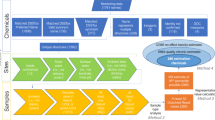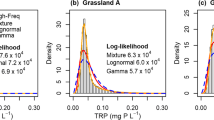Abstract
Inclusion of pesticide monitoring data in pesticide risk assessment is important yet challenging for several reasons, including infrequent or irregular data collection, disparate sources procedures and associated monitoring periods, and interpretation of the data itself in a policy context. These challenges alone, left unaddressed, will likely introduce unintentional and unforeseen risk assessment conclusions. While individual water quality monitoring programs report standard operating procedures and quality control practices for their own data, cross-checking data for duplicated data from one database to another does not routinely occur. Consequently, we developed a novel quality control and assurance methodology to identify errors and duplicated records toward creating an aggregated, single pesticide database toward use in ecological risk assessment. This methodology includes (1) standardization and reformatting practices, (2) data error and duplicate record identification protocols, (3) missing or inconsistent limit of detection and quantification reporting, and (4) site metadata scoring and ranking procedures to flag likely duplicate records. We applied this methodology to develop an aggregated (multiple-source), national-scale database for atrazine from a diverse set of surface water monitoring programs. The resultant database resolved and/or removed approximately 31% of the total ~ 385,000 records that were due to duplicated records. Identification of sample replicates was also developed. While the quality control and assurances methodologies developed in this work were applied to atrazine, they generally demonstrate how a properly constructed and aggregated single pesticide database would benefit from the methods described herein before use in subsequent statistical and data analysis or risk assessment.



Similar content being viewed by others
Data availability
Federal-level pesticide datasets used in the current study are available in the WQP and NWIS sources, available at https://www.waterqualitydata.us/ and https://waterdata.usgs.gov/nwis, respectively. Additional datasets used during the current study are available from the corresponding author on reasonable request. See Table 1 for a full list of data sources used in this study. The resultant database or data product generated from the current study is available in the supplementary information files.
Code availability
Availability of code used in production of this publication can be requested from the corresponding author.
References
Brain, R. A., Teed, R. S., Bang, J., Thorbek, P., Perine, J., Peranginangin, N., Kim, M., Valenti, T., Chen, W., Breton, R. L., Rodney, S. I., & Moore, D. R. J. (2015). Risk assessment considerations with regard to the potential impacts of pesticides on endangered species. Integrated Environmental Assessment and Management, 11(1), 102–117. https://doi.org/10.1002/ieam.1572
Chen, W., Hertl, P., Chen, S., & Tierney, D. (2002). A pesticide surface water mobility index and its relationship with concentrations in agricultural drainage watersheds. Environmental Toxicology and Chemistry, 21, 298–308.
Chen, W. (2005). Simple methods for estimating exposure concentrations of pesticide resulting from non-point source applications in agricultural drainage networks. In G. K. Ostrander (Ed.), Techniques in aquatic toxicology (Vol. 2). CRC Press LLC
Damalas, C. A., & Eleftherohorinos, I. G. (2011). Pesticide exposure safety issues and risk assessment indicators. International Journal of Environmental Research and Public Health, 8, 1402–1419. https://doi.org/10.3390/ijerph8051402
EPA. (1998). Guidelines for ecological risk assessment. EPA/630/R-95/002F. Federal Register, 63(93), 26846–26924. https://www.epa.gov/sites/production/files/2014-11/documents/eco_risk_assessment1998.pdf
EPA. (2006). Atrazine: Finalization of interim reregistration eligibility decision and completion of tolerance reassessment and reregistration eligibility process. EPA public docket: EPA-HQ-OPP-2005–0481. www.regulations.gov
EPA. (2019). FIFRA SAP: Notice of public meeting: Approaches for quantitative use of surface water monitoring data in pesticide drinking water assessments. EPA-HQ-OPP-2019-0417. www.regulations.gov
Exner, M. E., Spalding, R. F., & Harrell, D. M. (2005). Development of a quality-assessed agrichemical database for monitoring anthropogenic impacts on ground-water quality. Environmental Monitoring and Assessment, 107, 249–257. https://doi.org/10.1007/s10661-005-3108-0
Lewis, K. A., Tzilivakis, J., Warner, D. J., & Green, A. (2016). An international database for risk assessment and management. Human and Ecological Risk Assessment: An International Journal, 22(4), 1050–1064. https://doi.org/10.1080/10807039.2015.1133242
Mosquin, P., Aldworth, J., & Chen, W. (2016). Kriging models predicting atrazine concentrations in surface water draining agricultural watersheds. Journal of Environmental Quality, 45, 1680–1687.
Mosquin, P., Aldworth, J., & Chen, W. (2018). Flow-covariate prediction of stream pesticide concentrations. Environmental Toxicology and Chemistry, 37, 260–273.
Mosquin, P., Whitmore, R. W., & Chen, W. (2012a). Estimation of upper centile concentrations using historical atrazine monitoring data from community water systems. Journal of Environmental Quality, 41, 834–844.
Mosquin, P., Whitmore, R. W., & Chen, W. (2012b). Estimation of upper centile concentrations using historical atrazine monitoring data from community water systems. Journal of Environmental Quality, 41, 170–178.
Murphy, J. C., & Shoda, M. E. (2020). Pooling resources across organization – Multisource water-quality data for the Delaware River Basin (p. 2). U.S. Geological Survey fact sheet 2020–3006. https://doi.org/10.3133/fs20203006
Oelsner, G. P., Sprague, L. A., Murphy, J. C., Zuellig, R. E., Johnson, H. M., Ryberg, K. R., Stets, J. A., Vecchia, A. V., Riskin, M. L., De Cicco, L. A., Mills, T. J., & Farmer, W. H. (2017). Water quality trends in the nation’s rivers and streams 1972–2012 – Data preparation statistical methods and trend results (p. 136). U.S. Geological Survey scientific investigations report 2017–5006. https://doi.org/10.3133/sir20175006
Post, E. (2007). Designing and implementing a grid application for cumulative agrichemical residue tracking using third-party data sources and software components. Journal of Research and Practice in Information Technology, 39(2), 125–136.
Read, E. K., Carr, L., De Cicco, L., Dugan, H. A., Hanson, P. C., Hart, J. A., Read, J. S., & Winslow, L. A. (2017). Water quality data for national-scale aquatic research: The water quality portal. Water Resources Research, 53(2), 1735–1745.
Shoda, M. E., Murphy, J. C., Falcone, J. A., & Duris, J. W. (2019). Multisource surface-water-quality data and U.S. Geological Survey stream gage match for the Delaware River Basin. U.S. Geological Survey data release. https://doi.org/10.5066/P9PX8LZO
Sprague, L. A., Oelsner, G. P., & Argue, D. M. (2016). Challenges with secondary use of multi-source water quality data in the Unites States. Water Research, 110(1), 252–261. https://doi.org/10.1016/j.watres.2016.12.024
USEPA. (2004). Memorandum of Agreement Between the U.S. Environmental Protection Agency and Agan Chemical Manufacturing, Dow AgroSciences, Drexel Chemical, Oxon Italia S.P.A., and Syngenta Crop Protection Concerning the Registration of Pesticide Products Containing Atrazine. EPA-HW-OPP-2009-0104-0053. www.regulations.gov
USGS (U.S. Geological Survey). (2001). National water information system data available on the World Wide Web (water data for the nation). Accessed October 18, 2021, at http://waterdata.usgs.gov/nwis/
Vecchia, A. (2017). Model methodology for estimating pesticide concentration extremes based on sparse monitoring data. National Water Quality Program Scientific investigations report 2017–5159. https://doi.org/10.3133/sir20175159
Ye, M., Beach, J., Martin, J. W., & Senthilselvan, A. (2013). Occupational pesticide exposure and respiratory health. International Journal of Environmental Research and Public Health, 10, 6442–6471. https://doi.org/10.3390/ijerph10126442
Whitmore, R. W., & Chen, W. (2013). A survey sampling approach for pesticide monitoring of community water systems using groundwater as a drinking water source. Journal of Agricultural and Food Chemistry, 61, 11771–11781.
Zhang, X., Ensminger, M., Deng, X., Budd, R., Xie, Y., Wang, D., Singhasemanon, N., & Goh, K. (2019). The surface water database (SURF): A California database for surface water pesticide monitoring data. In: K. S. Goh, et al. (Eds.), Chapter 11 Pesticides in surface water: Monitoring, modeling, risk assessment, and management ACS symposium series. Washington, DC: American Chemical Society
Funding
This study was funded by Syngenta Crop Protection, LLC.
Author information
Authors and Affiliations
Contributions
All authors have agreed to the order and corresponding author designations.
Corresponding author
Ethics declarations
Ethics approval
The work presented in the study conforms to the requirements in the “Ethical Responsibilities of Authors” section of the journal author guidelines.
Consent to participate
Not applicable.
Consent for publication
Not applicable.
Conflict of interest
The authors declare no competing interests.
Additional information
Publisher's Note
Springer Nature remains neutral with regard to jurisdictional claims in published maps and institutional affiliations.
Supplementary information
Below is the link to the electronic supplementary material.
Rights and permissions
About this article
Cite this article
Perkins, D.B., Chen, W., Jacobson, A. et al. Development of a mixed-source, single pesticide database for use in ecological risk assessment: quality control and data standardization practices. Environ Monit Assess 193, 827 (2021). https://doi.org/10.1007/s10661-021-09596-9
Received:
Accepted:
Published:
DOI: https://doi.org/10.1007/s10661-021-09596-9




